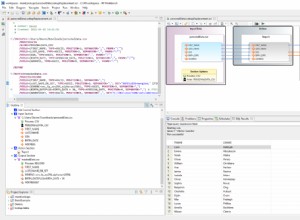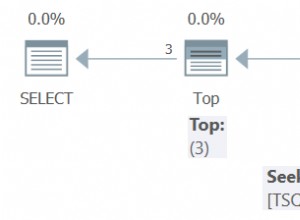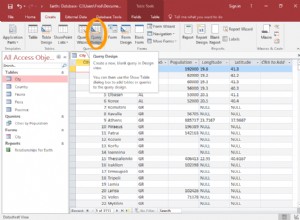Estamos usando double para almacenar latitude y longitude . Además, precalculamos (mediante disparadores) todos los valores que son precalculables cuando se observa un solo punto. Actualmente no tengo acceso a la fórmula que estamos usando, agregaré esto más tarde. Esto está optimizado para un equilibrio óptimo entre velocidad y precisión.
Para búsquedas en áreas definidas (dame todos los puntos dentro de x km) almacenamos adicionalmente el valor de latitud/longitud multiplicado por 1e6 (1,000,000) para que podamos limitarnos a un cuadrado comparando rangos de enteros, lo cual es muy rápido, por ejemplo,
lat BETWEEN 1290000 AND 2344000
AND
lng BETWEEN 4900000 AND 4910000
AND
distformularesult < 20
EDITAR:
Aquí está el formulario y el precálculo de valores del lugar actual en PHP.
WindowSize es un valor con el que tienes que jugar, es un factor de grados 1e6, que se usa para reducir los posibles resultados en un cuadrado alrededor del centro, acelera la búsqueda de resultados; no olvides que debería ser al menos el tamaño de su radio de búsqueda.
$paramGeoLon = 35.0000 //my center longitude
$paramGeoLat = 12.0000 //my center latitude
$windowSize = 35000;
$geoLatSinRad = sin( deg2rad( $paramGeoLat ) );
$geoLatCosRad = cos( deg2rad( $paramGeoLat ) );
$geoLonRad = deg2rad( $paramGeoLon );
$minGeoLatInt = intval( round( ( $paramGeoLat * 1e6 ), 0 ) ) - $windowSize;
$maxGeoLatInt = intval( round( ( $paramGeoLat * 1e6 ), 0 ) ) + $windowSize;
$minGeoLonInt = intval( round( ( $paramGeoLon * 1e6 ), 0 ) ) - $windowSize;
$maxGeoLonInt = intval( round( ( $paramGeoLon * 1e6 ), 0 ) ) + $windowSize;
Buscar todas las filas dentro de un rango específico de mi centro
SELECT
`e`.`id`
, :earthRadius * ACOS ( :paramGeoLatSinRad * `e`.`geoLatSinRad` + :paramGeoLatCosRad * `m`.`geoLatCosRad` * COS( `e`.`geoLonRad` - :paramGeoLonRad ) ) AS `geoDist`
FROM
`example` `e`
WHERE
`e`.`geoLatInt` BETWEEN :paramMinGeoLatInt AND :paramMaxGeoLatInt
AND
`e`.`geoLonInt` BETWEEN :paramMinGeoLonInt AND :paramMaxGeoLonInt
HAVING `geoDist` < 20
ORDER BY
`geoDist`
El formulario tiene una precisión bastante buena (por debajo de un metro, dependiendo de dónde se encuentre y qué distancia hay entre el punto)
Precalculé los siguientes valores en la tabla de mi base de datos example
CREATE TABLE `example` (
`id` int(11) NOT NULL AUTO_INCREMENT,
`geoLat` double NOT NULL DEFAULT '0',
`geoLon` double NOT NULL DEFAULT '0',
# below is precalculated with a trigger
`geoLatInt` int(11) NOT NULL DEFAULT '0',
`geoLonInt` int(11) NOT NULL DEFAULT '0',
`geoLatSinRad` double NOT NULL DEFAULT '0',
`geoLatCosRad` double NOT NULL DEFAULT '0',
`geoLonRad` double NOT NULL DEFAULT '0',
PRIMARY KEY (`id`),
KEY `example_cIdx_geo` (`geoLatInt`,`geoLonInt`,`geoLatSinRad`,`geoLatCosRad`,`geoLonRad`)
) ENGINE=InnoDB DEFAULT CHARSET=utf8 COLLATE=utf8_unicode_ci ROW_FORMAT=DYNAMIC
Activador de ejemplo
DELIMITER $
CREATE TRIGGER 'example_before_insert' BEFORE INSERT ON `example` FOR EACH ROW
BEGIN
SET NEW.`geoLatInt` := CAST( ROUND( NEW.`geoLat` * 1e6, 0 ) AS SIGNED INTEGER );
SET NEW.`geoLonInt` := CAST( ROUND( NEW.`geoLon` * 1e6, 0 ) AS SIGNED INTEGER );
SET NEW.`geoLatSinRad` := SIN( RADIANS( NEW.`geoLat` ) );
SET NEW.`geoLatCosRad` := COS( RADIANS( NEW.`geoLat` ) );
SET NEW.`geoLonRad` := RADIANS( NEW.`geoLon` );
END$
CREATE TRIGGER 'example_before_update' BEFORE UPDATE ON `example` FOR EACH ROW
BEGIN
IF NEW.geoLat <> OLD.geoLat OR NEW.geoLon <> OLD.geoLon
THEN
SET NEW.`geoLatInt` := CAST( ROUND( NEW.`geoLat` * 1e6, 0 ) AS SIGNED INTEGER );
SET NEW.`geoLonInt` := CAST( ROUND( NEW.`geoLon` * 1e6, 0 ) AS SIGNED INTEGER );
SET NEW.`geoLatSinRad` := SIN( RADIANS( NEW.`geoLat` ) );
SET NEW.`geoLatCosRad` := COS( RADIANS( NEW.`geoLat` ) );
SET NEW.`geoLonRad` := RADIANS( NEW.`geoLon` );
END IF;
END$
DELIMITER ;
¿Preguntas? De lo contrario diviértete :)




